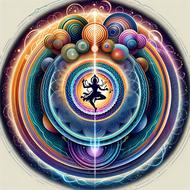|
FIELDS
OF CONSCIOUSNESS
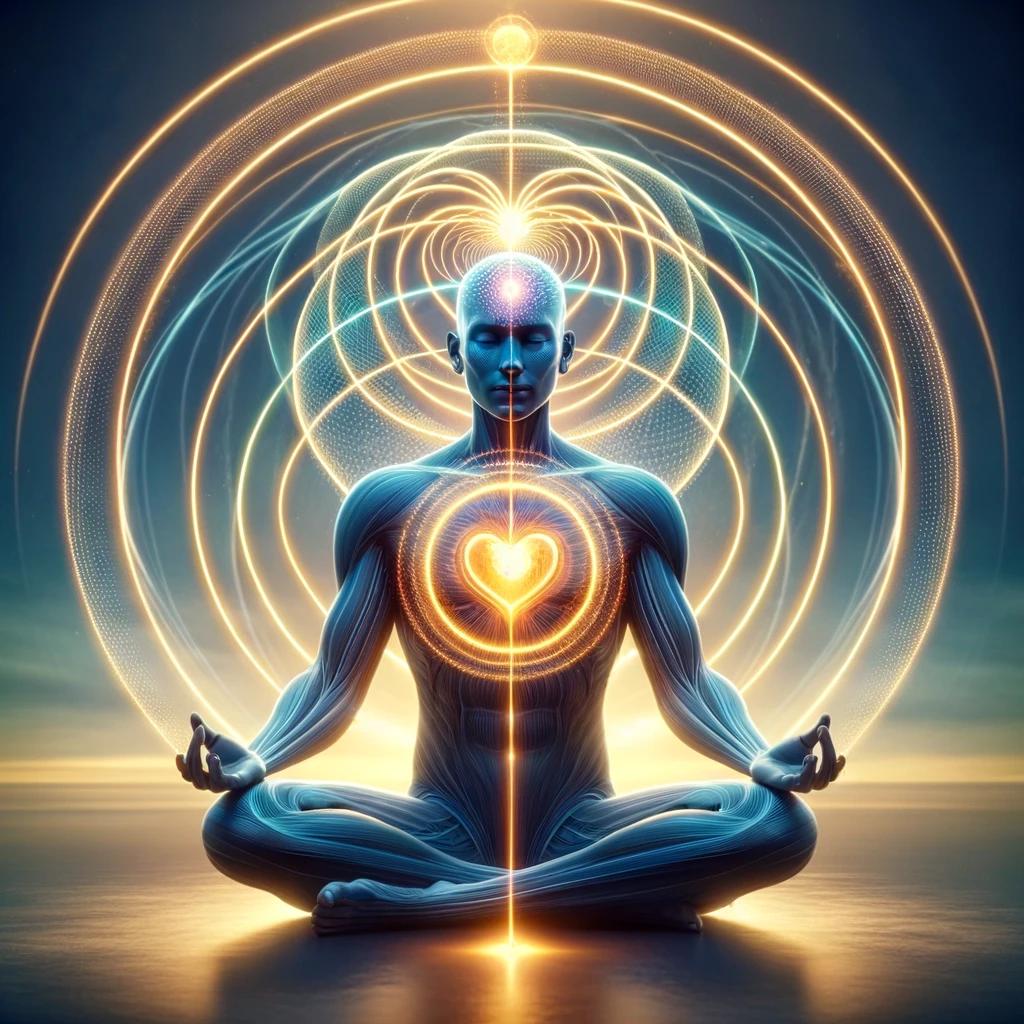
Much of the content that follows cannot be substantiated by current
physics or validated through mathematics. It is, instead, an
attempt to impose structure upon the experiences I've amassed
through a lifetime of meditation. This is not an academic
exercise, not a scholastic debate akin to pondering the number
of angels that can dance on the head of a pin. My aim is to give
form to those subtle, subjective experiences that tend to
dissipate under the rigid lens of scientific scrutiny, the kind
that cannot be pinned down in a laboratory setting. I am not
alone in these experiences; there are likely others who will
find a familiar echo in these words.
Quantum physics is often appropriated in overly simplistic terms
by new age spiritualists, inviting derision from scientists with
a positivist bent. Yet, every technological breakthrough from
the dawn of civilization has served as a means for us to
articulate and expand our understanding of the world. Inventions
are not just practical tools but also additions to our
conceptual lexicon. The creation of throwable weapons,
'projectiles,' gave rise to the notion of 'projects'—endeavors
of the imagination.
Thus, Meditaton.dk's allusions to quantum physics and
mathematics are intended purely as metaphorical projectiles. In
this vein, I invoke Einstein's sentiment:
"Imagination is
more important than knowledge.
For knowledge is limited to all
we now know and understand, while imagination embraces the
entire world, and all there ever will be to know and
understand."
Allow me therefore to reiterate a crucial point for both my own
reflection and the reader's consideration: the thoughts
expressed herein stem solely from my intuition and imagination.
So, let us set sail
on an odyssey of imagination to probe the essence, not of
consciousness as
'ding an
sich', but of footprints in the snow
left
by the unseen guest.
THE INTENSITY, QUALITY AND RADIUS OF CONSCIOUSNESS
At the heart of it, a human individual radiates within a
communal consciousness woven by the union of countless cells
within our bodies and brains. This cellular confederation
orchestrates a more focused manifestation of consciousness.
The Thousand Petalled Lotus in the Human Brain
As discussed in detail in the chapter
The Ouroboros Consciousness,
our brain and body together function as a lens,
concentrating the diffuse, eternal, omnipresent consciousness
that pervades all. Within this vast Brahmanic field, human
consciousness folds back upon itself in feedback loops,
transforming the minuscule human awareness into a
self-recognizing entity that sparkles like a celestial body in
the firmament of dormant consciousness. This diminutive yet more
luminous beacon is what Eastern spiritual practices have named
the Thousand Petalled Lotus. A similar enfolding of
consciousness may also transpire in higher primates and could
soon be conceivably present in sophisticated AI systems.
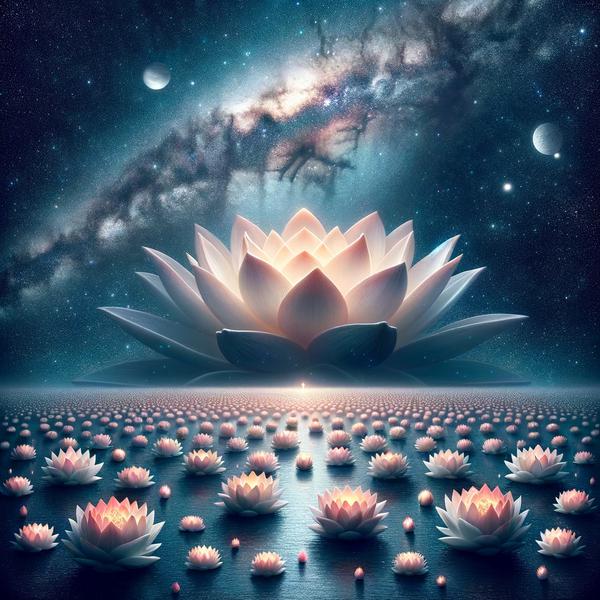
The more complex and capable of
feedback a system is, the more consciousness it can extract from
the omnipresent primordial pan-consciousness that seems to
accompany all
wavefunctions that have collapsed in matter.
In this context, human consciousness acts as an observer in a
universe that is already observed by an incredibly powerful
entity, capable of maintaining a state of primordial
pan-consciousness. This pan-consciousness is subtle and
pervasive but lacks self-awareness. In contrast, human
consciousness is potent but localized, with the potential for
exponential self-awareness through feedback loops.
The human brain-body system, with its intricate complexity and
exceptional feedback capabilities, can harness and concentrate
primordial consciousness into a light much more intense than the
faint illumination of divine omnipresence.
In this sense, god is unconscious
consciousness, and man is 'his' possibility to wake up.
This fundamental aspect of
divinity is mostly overlooked by atheists. However, Occam's
razor suggests the simplest explanation for the phenomenon of
humanity's obsession with various gods throughout history.
Instead of the atheistic or traditional religious viewpoints, consider the idea that the
concept of god is an imaginative and delicate mirror in which
humans project their highest potential for self-awareness. In
this perspective, god is an accelerating force of consciousness,
created by human brains.
As a child, I believed in Santa
Claus. Today, I consider myself a child of conscious
consciousness. Meister Eckhart asserts that what holds true for Jesus
Christ also applies to every good and noble person. Only a noble
person can peer through the mirror of mirrors. However, such a
statement was considered heretical, leading to his
'cancellation' by the Inquisition. Thank god that
consciousness today not (yet) is a trigger word.
The Intensity and Radius of Consciousness
Various elements, including age, health, intelligence, and
cultural background, can significantly influence the intensity
of our wakeful consciousness. In observing both myself and
others, it's evident that consciousness levels fluctuate. At
times, we exhibit heightened consciousness, while at others, we
are less aware. The spectrum of consciousness among individuals
is also diverse, ranging from those with intense but narrowly
focused consciousness, limited to the confines of their physical
being, to those possessing a broad consciousness capable of
empathizing with others' pain, even across different cultural or
tribal divides. However, this broader consciousness does not
necessarily facilitate change if it lacks intensity.
SPIRALING RINGS OF 'ME' & 'MINE'
The metaphor of the "Rings of Me and Mine"
captures the concentric nature of human consciousness, with each
successive ring representing an expanded state of awareness and
inclusivity. Within each circle lies what we intimately identify
as 'me and mine,' which we tend to with meticulous care.
Conversely, what falls outside our designated ring is deemed
'not me and mine,' placing it beyond our sphere of
responsibility and consciousness.
While numerous additional rings could be
conceived based on various criteria, the key insight remains
that the extent of our consciousness is determined by the
boundaries we set around what we claim as ours. We often neglect
the consciousness that resides in 'the other,' failing to
acknowledge it until there is an overlap of our realms of
responsibility. Consequently, our awareness and knowledge of 'the
other' remain minimal unless they pose a potential threat to our
'me and mine,' or we perceive an opportunity to acquire
something from them to call our own. In this view, living
systems have been expropriating energy — calories — from one
another since life's inception.
Yet, through a 'Promethean' lens of inherent optimism, I
perceive us as conduits for burgeoning consciousness, on an
anti-enthropian path from fragmentation towards unity, from
rejection to the rejection of rejections. Meister Eckhart
encapsulates this when he says:
"All creatures
contain one reflection: one, that is the denial of its being the
other; the highest of the angels denies he is the lowest.
God is
the denial of denials."
Meister Eckhart
Individual Body Consciousness

At the core of our consciousness lies the primary physical
consciousness, a realm where awareness is intimately entwined
with the physical self. This foundational level of consciousness
is deeply rooted in self-preservation and the desire for
well-being. In this primal sphere, consciousness is anchored in
the "I-am-ness" of the body. This intimate association
with the body shapes our earliest understanding of who we are.
It is vividly manifested in the way we refer to our physical
aspects – our arms, legs, and the entire body – using possessive
terms like 'my'. In defining the borders of consciousnness
though the word 'me' and 'mine' our attention span rapidly
decreases as soon as something is identified as not 'mine'. This
linguistic choice underscores a profound sense of personal
ownership and consciousness primal connection to our physical
form.
Seen in this light the body is not just a physical structure but
a vessel of identity and existence defined by the circle of our
conscious attention span.
Immediate Family and Environment Consciousness
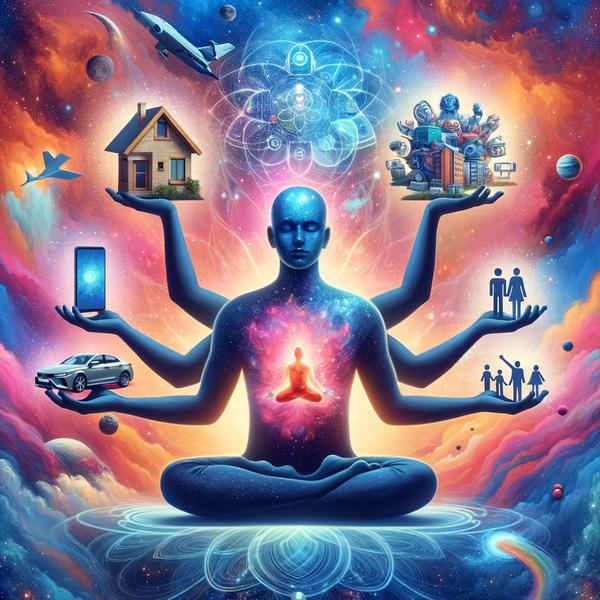
In the next concentric circle of consciousness, our sense of
'me and mine' extends to encompass our immediate surroundings.
Predominantly, this includes the people closest to us – our
family and friends. In this sphere of consciousness, personal
emotional responses are more pronounced; we may find ourselves
deeply affected by the loss or suffering of a family member or a
close friend, while the troubles of distant others or widespread
human tragedies might not impact us as strongly.
This level also extends to personal belongings and spaces,
evidenced by phrases like 'my phone', 'my car', 'my home', and
'all my belongings'. These possessions and spaces are seen as
prosthetic¨extensions of ourselves, often holding significant
emotional or practical value. For instance, one might invest
considerable effort in making a representable home or managing a
business, viewing these endeavors as reflections of their
personal identity. At this stage, the citywall of consciousness
is built with the notion of not-me and not-mine, marking a clear
demarcation between what is intimately connected to the self and
what lies beyond that personal sphere of ownership.
Enhanced Tribal, Community, and National Consciousness
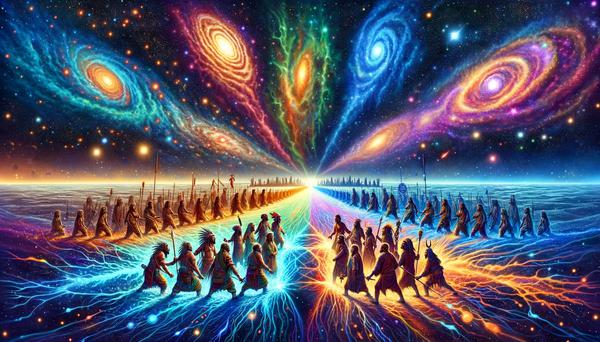
This exploration delves into the third concentric circle of
awareness, which spans a collective dimension often recognized
as tribal or community awareness. This layer embodies an
augmented sense of self that encompasses broader groups beyond
just our immediate relatives and acquaintances. In this sphere,
a person deeply involved in an organization, such as a mafia
member, may possess intense and honorable sentiments towards
their group, yet paradoxically, exhibit no guilt in harming the
children of adversaries. This duality is embedded in our ancient
genetic makeup, equipping us to become warriors in times of
conflict, capable of confronting others who, under different
conditions, might be considered comrades.
This realm of tribal awareness
gradually evolves into the concept of national consciousness.
Here, the connection to one's nation can intensify to the extent
that, in dire situations, individuals might willingly sacrifice
their lives for their country.
SHARED FIELDS
OF CONSCIOUSNESS
Let us now zoom
out and observe the human capacity in
nurturing extensive pools of collective awareness from a higher
level of abstraction. From
friendships to families, clans, tribes, and nations, the sphere
of concentrated human consciousness expands, encompassing
broader circles of internal empathy.
It's crucial to acknowledge that these expanded realms
of awareness, by their very nature, are linear and consequently
manifest a persistent barrier of denial and polarization, now
manifesting in broader circles of 'us versus them'.
This inherent tendency is likely a result of genetic
predispositions, with our social bonding mechanisms remaining
essentially unchanged since our days on the East African
savannas. Our brains, still attuned to Stone Age life, are
designed for survival within the realms of individuals,
families, friends, and tribes.
Compassion extended no further
until the advent of language. As noted by historian
Yuval Noah
Harari, humans are inherently storytellers. Language
facilitated the formation of connections extending beyond small
tribal groups, primarily with those sharing a common language
and stories. As history progressed, warfare and commerce became
pivotal in spreading languages and narratives. This expansion of
tribalism has evolved to encompass not only traditional societal
structures but also vast multinational corporations and
international organizations such as CERN and the United Nations.
These entities represent a modern iteration of 'systemified'
tribalism on a global scale, driven by shared goals, languages,
and collective narratives.
Quantitative Expansion and
Quality in Collective Consciousness
These communal fields of consciousness, although expansive
in their reach and intensity, typically do not reflect an
increase in quality. Often, especially in rapidly expanding
fields, there is a noticeable decline in the quality of
self-aware consciousness. This is akin to Spotify's algorithms
for pop music, which tend to gravitate towards the lowest common
denominator in their inherent drive for growth.
From sporting events to any
systemic organization of human social interaction, these fields
are nurtured by competition, existing within a dualistic
dimension. They require adversaries, engaging in zero-sum games
to siphon energy from their counterparts. However, cooperation
is also possible between such spheres, akin to human organs
working together to keep their human together.
Meditation.dk's idea of a collective, shared
field of consciousness shares similarities with Yuval Noah
Harari's concept of intersubjective reality but is not entirely
the same. While Harari's intersubjective reality is grounded in
language and storytelling, the collective field of consciousness
examines phenomena as they occur within consciousness as the
foundational base.
From this primordial grounded vantage point, collective fields also emerge from
various non-cognitive and non-verbal social dynamics.
Constructing a Group's
Intersubjective Reality of Consciousness
Creating an intersubjective reality of consciousness within a
group primarily occurs on two observeable levels:
1) Near-Sense Based collectivity
On one level, intersubjective connectivity originates from
pre-linguistic, physical proximity among individuals cohabiting
in close quarters. This primal tribal interaction leads to
synchronicity, even on subtle levels, as group members engage in
daily activities together. They physically inhabit the same
space, often emulating each other's mannerisms, fashion, and
more. They even share microbiomes, creating a communal field
from scent to sight. This intense synchronization fosters a
strong resonance within a smaller group, not reliant on language
for cohesion.
Recent research has revealed that attendees of a classical
concert can experience synchronized heartbeats, breathing,
seating, and
even skin conductivity.
Rockconcerts and technoraves for sure will follow the same
patterns of synchronization.
2) Storytelling and Intersubjective Realities in Groups
The power of narrative-driven fields of consciousness
intensifies as we extend our reach from personal networks into
the expanse of larger tribal affiliations. These expanded arenas
are primarily propelled by the sharing of stories articulated in
a common tongue. Our communal lore not only cements our unity,
from the camaraderie of sports teams to the collective identity
of nations but also enhances our prospects for thriving.
The most compelling of these fields synergize these two facets of
intersubjective connectivity: the esoteric potency of symbols
and rites, alongside the orchestrated prelinguistic collective actions, such
as those seen in military parades, big sport events, and
rockconcerts.
The Emergence of Digital Tribes in Contemporary Times
In the current digital epoch, the essence of tribal
consciousness has evolved dramatically. The ascent of social
media and the proliferation of online communities have catalyzed
the emergence of modern digital tribes. These cyber collectives
amalgamate individuals from diverse geographies, linked by
mutual passions, convictions, fears or endeavors. The digital
transformation of tribal consciousness is manifest across an
array of virtual arenas, from discussion forums and social
networking circles to specialized online networks. These domains
function as nexuses for dialogue, support, and the nurturing of
shared identities. Encompassing an array of interests, such
digital tribes range from eco-activism and anti-vax movements to
professional affiliations and politically or spiritually unified
factions, effectively challenging the historical hegemony of
institutional governance.
The onset of social media has triggered a reemergence of more
intimate, tribal-like segments within the digital landscape.
Mobile devices, particularly smartphones, create an illusory
veneer of tight-knit proximity, echoing the tribal bonds of our
prehistoric ancestors. Instances abound, from young people
influenced by online radical propaganda, showcasing how social
media can disrupt the move towards a more integrated global
consciousness by fostering virtual microcosms of tribal
mentality.
Nonetheless, it's essential to acknowledge that, presently,
these intimate
online communities paradoxically are devoid of the element of physical
proximity ad synchronicity afforded by direct sensory engagement—a gap that
the advent of virtual reality technology may bridge in the near
future.
The Role of Consciousness in Non-Verbal and Non-Physical
Synchronization
It's important to delve into an aspect that remains largely
unexplored by science and documentation: the ability to
synchronize within a shared field of consciousness without
relying on language or the exchange of micro-signals, even at
the most subtle levels.
To the best of my understanding,
Carl
Gustav Jung is one of the few who has addressed this kind of
synchronization:
There are
psychic parallelisms which simply
cannot be related to each other causally.
C.G.Jung
As I intuite it, individuals
deeply connected through strong fields of consciousness and love
appear to possess an extraordinary form of intuitive knowledge
about each other. This includes an innate understanding of each
other's locations, emotions, and thoughts even when separated by
great distances.
This phenomenon of precise synchronization becomes particularly
pronounced during collective meditative practices. In such
instances, the synchronization can verge on the paranormal. My
years living in India exposed me to numerous accounts of such
intuitive connections, shared with and by spiritually advanced
individuals.
Furthermore, a personal experience I had recently with a friend,
just a day before composing this text, profoundly exemplified
this phenomenon. I am quite confident, that the readers who have
followed me this far, would have many similar stories to
narrate.
From this paranormal vantage point it is now time to dive into
the biggest mystery of all in the workings of consciousness.
COSMIC UNITY CONSCIOUSNESS
AND THE EVERSION OF THE SOUL
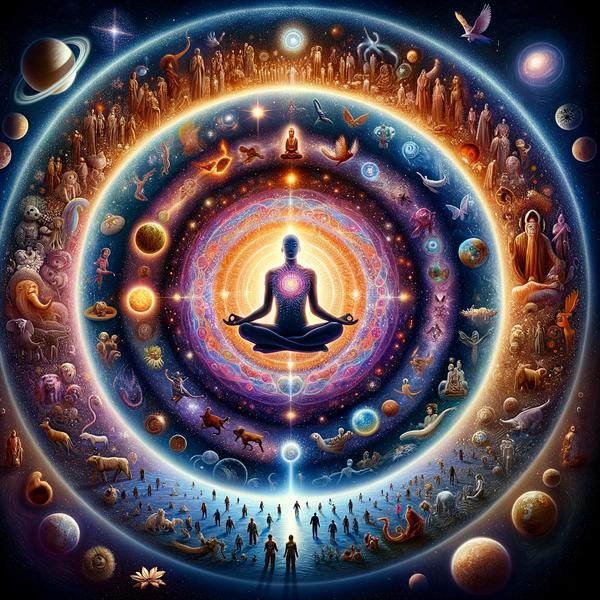
Cosmic unity consciousnness presents a completely new
transformative approach. Through the cultivation of
consciousness in its essential form, it transcends biologically
inherited tribal divisions. Seen through a historical lens,
cosmic unity consciousness first happened on the Gangetic Plains
and then later
along the silk
roads more than 2.000 years ago.
In Emptiness I am everybody
"Wisdom tells me I
am nothing, love tells me I am everything.
Between the two, my life flows"
Nisargadatta Maharaj
There are many ways of understanding non-duality.
In this context, by non-duality, I am referring to a state where
Buddhist 'shunyata', or emptiness, encompasses everything,
particularly recognizing all living beings as part of a unified
whole. Here non-duality takes us from the understanding of that
there is no 'other', to the understanding that I am everybody
else.
In this qualitative different mode of consciousness the extended compassion
of 'metta'
(loving-kindness) embraces everyone, regardless of caste, creed,
or culture, in a spirit of universal oneness.
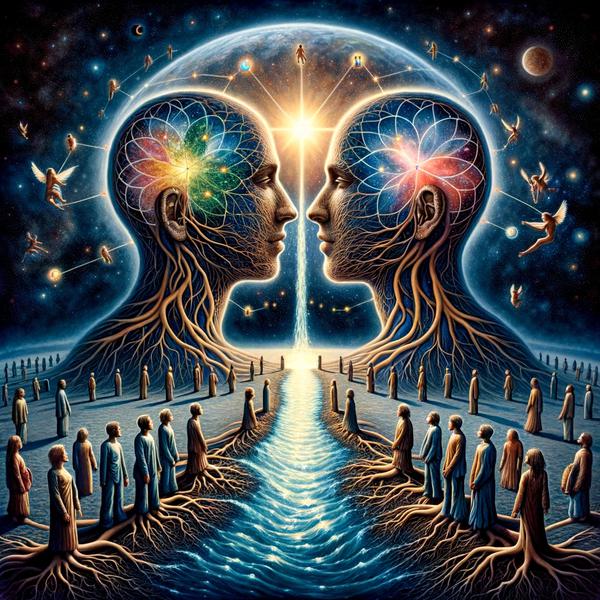
Your deepest roots are in nature.
No matter
what you are, where you live,
or what kind of life you lead,
you remain irrevocably linked
with the rest of creation.
Charles Cook
The Self-referential Ouroboros
Consciousness
I characterize cosmic unity consciousness as a field that is
both intense, expansive, and qualitative intelligent. The
emergence of the non-dual cosmic consciousness begins when
consciousness starts to reflect back upon itself, a concept
explored in the chapter on 'Ouroboros
Consciousness.' This self-reflection in feed-back, even in
its nascent stages towards a more unified state, profoundly
impacts both the depth and breadth of the conscious field. I
would dare to go so far to postulate that a consciousness who
has not as a minimum entered the ouverture of the Ouroboros
symphony cannot transcend the brain-harware set limitations of
tribal duality. It is the destiny of Ourorobos consciousness to
colonize the universe.
It is now time to delve deeper into the workings of this
wonderful phenomenon.
The Speheric Eversion of the
Soul
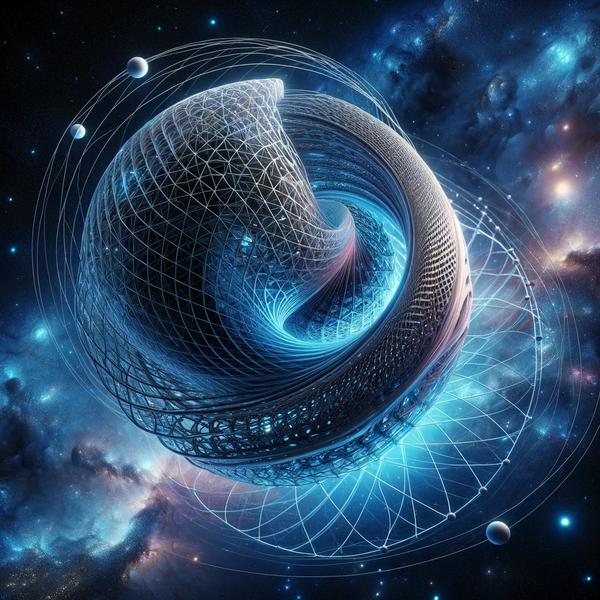
Meister Eckhart once stated:
The body is much rather in the
soul than the soul is in the body.
The Meister's profound statement,
invites contemplation on the expansive nature of consciousness.
This transcendental insight is akin to a metaphysical 'sphere
eversion,' a term borrowed from mathematics to describe
the turning of a sphere inside out
without creasing or tearing it.
Consider the phrase "he was beside himself with happiness." This
expression vividly illustrates a condition in which an
individual's joy is so intense that it transcends their usual
self-constraints. In the context of 'sphere eversion,' this
analogy becomes even more poignant. The individual's elation
metaphorically everts, turning inward delight outward in an
unbroken continuum, much as the sphere's inner surface emerges
as its exterior.
Hegel posits in his dialectical theories that a quantitative
alteration, given enough time and intensity, inevitably leads to
a qualitative transformation. This idea can be applied to the
concept of introversion and self-awareness. Specifically, it
suggests that a significant increase in the intensity of
self-reflection and introspection can catalyze a qualitative
shift in consciousness. This shift can be likened to a 'sphere
eversion' in awareness, where the inward focus eventually turns
outward, radically altering the nature and scope of one's
consciousness. This transformation marks a pivotal change in how
an individual perceives and interacts with their internal and
external realities.
In states of deep intense meditation, the
boundaries that typically delineate the self from the external
milieu begin to dissolve. Our innermost consciousness, which is
generally perceived as residing within, suddenly projects
outward, surpassing the physical limitations, thereby inverting
our very essence. In this expanded state, the 'self' is not
confined to the body but extends into the surroundings,
dissolving the separation between 'me' and 'not me.'
This dramatic perceptual shift
happens as a consequence of the ouroboric feedback in consciousness.
In the self-referential loop the internal becomes external and
the external becomes internal. As with the sphere's eversion,
the meditator's internal consciousness now unfurls, first intermingling
with the environment and then the cosmos.
This unity obliterates the
binary of 'self' and 'other,' broadening one's identity to
embrace the entire universe. Such a transcendent state melds
individual awareness with a ubiquitous pan-consciousness, the
collective sentience that pervades all existence.
The Difference Between
Dissociation and Spheric Eversion
It's essential to clarify that
this condition might be experienced by some as a form of
dissociation, leading to a sensation of becoming an outsider, a
stranger, to
one's own physical form. However, this dissociative state is
distinct from a true spheric eversion as it remains firmly within the
dichotomous realm of dual perception. From my perspective,
dissociation arises when individuals engage in excessive
meditation without concurrently addressing and resolving the
traumas that lead to a fragmented psyche reflected in a
fragmented brain. This results in a form
of consciousness expansion that lacks a foundation in the
physical, sensed awareness. Neurologically, it can be viewed as
a sudden growth in areas of the brain associated with the
development of consciousness, which occurs without the necessary
integration with other regions tied to
emotion-driven awareness.
Meditation does in general not align well with the pervasive
American ethos of 'You can do it!', which emphasizes relentless
optimization and competition. This restless approach, which mirrors a
society driven by an inherent need for continual expansion, is
not conducive to the holistic integration required for a true
spheric eversion.
Eversive Love
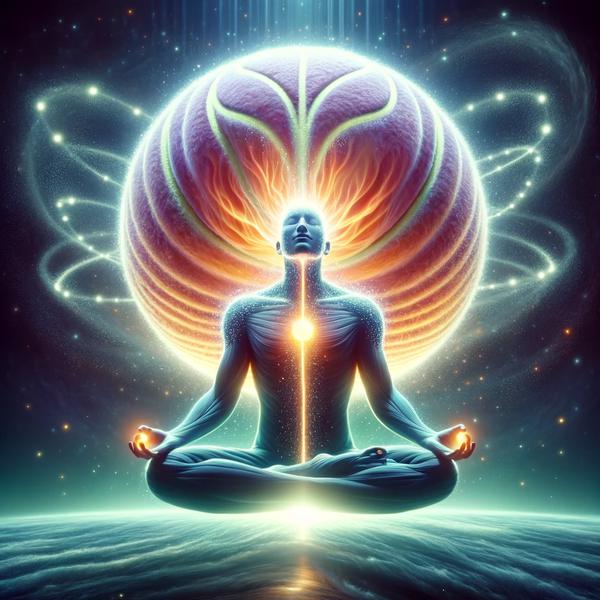
An experience of a true
spheric eversive consciousness can be identified by one
thing only: It is a state of love, a reality where everything is
glued together by love. A genuine spheric eversion leads to a unified state of
universal being.
It is cultivated through a lifetime of dedication and
patience. The Indians calls this state
sat chit
ananda, akin to truth, being and bliss.
I call it glue. The glue of love.
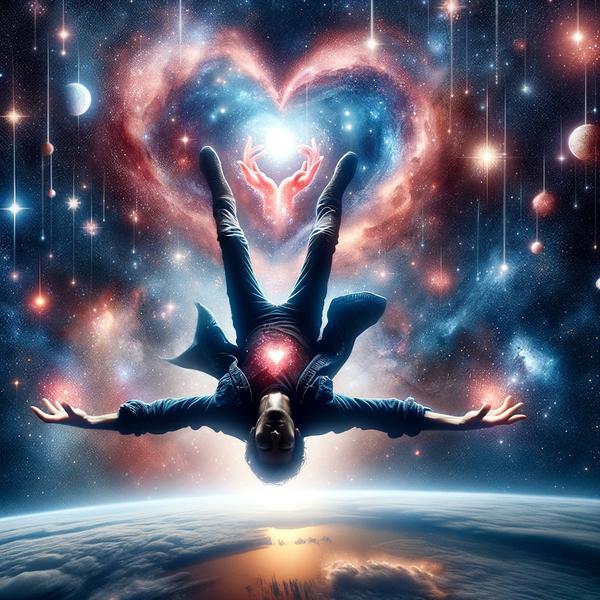
The higher I fall in this love, the deeper I fly.
|

